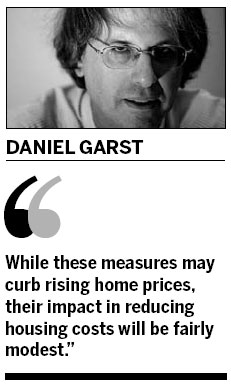 |
Large Medium Small |
Soaring residential real estate prices have convinced many that Beijing has a property bubble. That would be good news for first-time homebuyers frozen out of the market by high housing costs. After the US and Japanese real estate bubbles popped, property asset prices plunged, making housing more affordable.
But while Beijing's residential housing market has become frothy, the factors that fueled the latest Japanese and American property bubbles are largely absent here. Thus market corrections will only somewhat reduce the capital's sky-high home prices.

One heavily cited sign of a Beijing real estate bubble and an impending crash in housing prices is the ratio of home prices to average annual household incomes. This ratio now stands at 10 throughout China and is certainly higher in the capital. In most developed economies, by contrast, this ratio is four or five.
However, as Tao Wang, an economist at UBS argues, home buyers in Beijing come largely from the richest 20 percent to 30 percent of the city's population. Among these buyers, the ratio of home prices to average annual income is similar to that in developed economies. It is also much lower than the figure for Japan in 1990, which hit 18, forcing some buyers to take out 100-year mortgages.
Moreover, homeowners in the capital have much less debt compared with their counterparts in Japan during its late 1980s real estate bubble. Nearly one-quarter of buyers here pay with cash, while the average mortgage covers only half of a property's value. Owner- occupiers must make a minimum 20 percent deposit, investors a 40 percent deposit. Thus Chinese households' total debt currently stands at 35 percent of their disposable income, compared with 130 percent in Japan in 1990.
This lower debt load also distinguishes homeowners in the capital from American home buyers during the recent US housing bubble. That bubble was exacerbated by home purchases made with so-called "adjustable rate" mortgages involving little or no downpayment. This left many low-income homeowners burdened with excessive debt and vulnerable to declining housing prices.
Indeed, Andy Rothman, an economist at CLSA, estimates that only 25 percent of middle-class homeowners here have a mortgage. The average value of their loan is 46 percent of the property's value, compared with 76 percent in America.
The fact that Beijing's residential property boom is being financed out of savings, rather than loans, makes it much more robust, even under bubble-like conditions. When bubbles driven by lending begin to pop, highly leveraged buyers are forced to sell quickly, rapidly driving down home prices. This in turn generates the kind of vicious downward spiral seen in formerly "hot" US real estate markets, notably Las Vegas. Falling prices causes more buyers to default, increasing home foreclosures and causing further steep declines in real estate prices, as foreclosed homes flood the market. Less indebted homeowners with high savings levels can ride out such crises.
Finally, unlike US housing markets, the market for secondhand housing in Beijing is quite small. The reliance of home buyers on newly built apartment communities limits the housing supply, keeping demand high relative to supply and boosting apartment prices.
Although Beijing may not be facing genuine bubble trouble in its residential housing market, China's central government is clearly concerned about housing affordability. It has recently taken steps to cool down the currently red hot real estate markets in the capital and other big Chinese cities. These measures include stricter rules on investment property mortgages and efforts to curb illegal foreign capital flows into the property market. Bank reserve requirements have also been raised, along with the yield on central bank bills, to curtail last year's tidal wave of bank lending and reduce liquidity in the overall economy.
While these measures may curb rising home prices, the foregoing analysis suggests their impact, along with that of any market correction, in reducing housing costs will be fairly modest.
One fundamental problem underlying the housing affordability crisis is market failure. Most of the new apartment complexes now being built in central Beijing are luxury communities. One can't blame developers for building them, rather than less high-end and cheaper housing, as the former is much more profitable than the latter.
Thus the local governmental authorities need to do more to increase the supply of affordable housing, including subsidizing this kind of home construction. Unless such steps are taken, far too many of the capital's middle class residents with ordinary incomes will have to settle for overpriced and inferior housing.